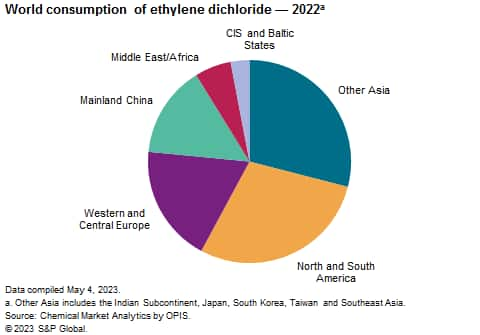Published July 2023
Ethylene dichloride (EDC) is used primarily for the production of vinyl chloride monomer (VCM), which is used mainly in the polymerization manufacture of polyvinyl chloride (PVC). PVC is commonly used in pipes, fittings, profiles, tubes, windows, doors, sidings, wire, cable, film, sheet and flooring. The vinyls industries include construction and infrastructure, agriculture, electrical products and healthcare. EDC is also used as an intermediate in the manufacture of chlorinated solvents and ethyleneamines, and as a solvent in the textile, metal cleaning and adhesive industries.
Northeast Asia is the largest EDC producing and consuming region worldwide, led predominantly by mainland China. North America is now the second-largest producer and consumer, but the United States remains the single-largest producer and consumer of EDC in the world. The United States is also the largest EDC exporter, as a result of advantaged production economics and healthy demand for caustic soda. Given Northeast Asia’s higher energy and feedstock costs, the region remains the largest importer of EDC.
The following pie chart shows world consumption of ethylene dichloride in 2022:

In 2022, over 98% of global EDC consumption was used for VCM production. Western Europe, mainland China and the United States have the most significant EDC consumption into non-VCM uses, primarily for chlorinated solvents, ethyleneamines and vinylidene chloride.
For more detailed information, see the table of contents, shown below.
S&P Global’s Chemical Economics Handbook – Ethylene Dichloride is the comprehensive and trusted guide for anyone seeking information on this industry. This latest report details global and regional information, including

Key benefits
S&P Global’s Chemical Economics Handbook – Ethylene Dichloride has been compiled using primary interviews with key suppliers and organizations, and leading representatives from the industry in combination with S&P Global’s unparalleled access to upstream and downstream market intelligence and expert insights into industry dynamics, trade and economics.
This report can help you
- Identify trends and driving forces influencing chemical markets
- Forecast and plan for future demand
- Understand the impact of competing materials
- Identify and evaluate potential customers and competitors
- Evaluate producers
- Track changing prices and trade movements
- Analyze the impact of feedstocks, regulations, and other factors on chemical profitability


















